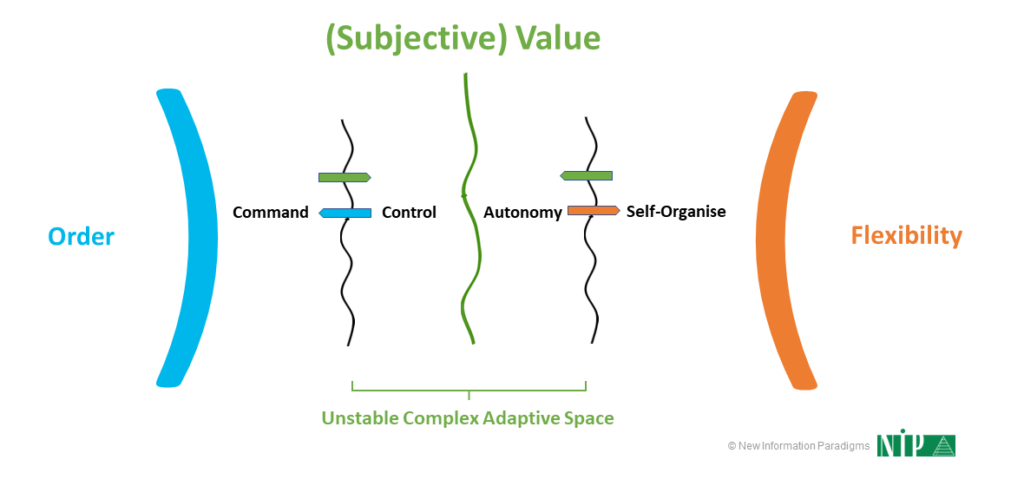Value Management: Value-Led
“Value” is one of the most used terms in today’s business lexicon; it is also one of the least understood.
In most cases, the heart of the problem is that Value is usually seen as ultimately objective.
Value is then treated almost exclusively as a noun, rather than a verb – as static, rather than dynamic:
- Interchangeable with “cost”, and ultimately reduced to, and expressed in, monetary terms.
- Defined upfront, and then managed with KPIs and data.
- Created by the producer and delivered to the consumer, as revealed by the ubiquitous term “value creation”.
There is an element of truth in each of these things: money is part of Value, it is important to both plan ahead and measure, and entrepreneurs do generate new ideas.
However, this narrow concept of “value” – representing (as we will see below) the most basic level of up to six levels of how Value can be considered – misses out the full richness of what it really is.
What Value Really Is
Value is ultimately what matters to – or is “valued” by – our customers, our stakeholders, and us as organisations.
This means that Value is not primarily objective, but instead primarily subjective:
- Driven by underlying values (ethics, character and cultural traits, etc) and past events.
- Defined, perceived and experienced by the customer; only facilitated by the producer.
- Mostly impossible to reduce to “cost” (hence the often huge discrepancies between book and market valuations).
- Variable between different contexts and over time.
Most of all, Value is therefore Complex – it emerges and changes, has rich interdependencies and can often be unpredictable – and whilst this brings huge challenges, it also presents a key opportunity.
Why Value Works
Precisely because Value is complex, it is at the heart of how organisations successfully navigate today’s Complex business environment.
At the most fundamental level, this is because Value balances the two potentially competing forces of flexibility and order:

- Flexibility: what is considered “valuable” varies infinitely between situations and over time (emerging from the unique and constantly changing interactions between those involved, and with the wider environment).
- Order: “value” is the universal guiding principle in all situations (as it is the one constant, or “attractor” of focus and activity, that can be referred to continuously – expressed as the Things That Matter, which provide sufficient order to guide activity and prevent chaos).
Value is also what engages people, motivates them and leads to change – clarifying priorities, driving decision-making and realising benefits.
In other words, Value not only reflects Complexity; it also gives shape to it, and lights the path through it.
Realising the Implications: Being Value-Led
Focusing on Value is therefore the only effective way to be in tune with, understand, and harness the elements and dynamics of complexity, rather than:
- Being a victim of Complexity, which leads to resignation or denial.
- Futilely attempting to resist, sidestep or control complexity, whether by doubling down or pursuing quick fixes.
This means prioritising discovering what is truly valuable in the situation – the Things That Matter – and understanding the underlying structure and dynamics that drive what this is.
After all, the other “mistake” when it comes to Value – less serious than seeing it as wholly objective, but still very limiting – is treating Value as entirely idiosyncratic and mysterious, when it actually has knowable structure and dynamics, and up to six different perspectives from which it can be considered.
The “Structure” of Value
In terms of structure and dynamics, the profile of values that drives what is considered “valuable” is different – idiosyncratic – every time. However, this profile is still drawn from a knowable and fixed set of these values:
- These foundational values are necessarily abstractions and generalisations that take particular form and expression in the detail of each situation, but they provide a “home” for every held “value”.
- They can also be organised in a way that maps adjacency and opposites, where adjacent values can be readily cultivated, whilst opposites are the sources of tension and indicate choices to be made.
- All values are tied to specific experiences that an entrepreneur is best-placed to pursue on the “production” side and that the consumer/customer will value on the “consumption” side.
The relevant values can therefore be clarified in a given situation, and congruence established, or differences understood and consciously managed.
This is the start of demystifying “value”.
Value Attitudes and Perspectives
This developing understanding is refined with an appreciation of the three successively more sophisticated and powerful attitudes towards Value:
- Cost-led / Data-aware: focussed on objective costs incurred on the “production” side.
- Exchange-led / Situation-aware: focused on quantifying the factors involved when the “production” side meets the “consumption” side.
- Value-led / Complexity-aware: appreciating Value in all its subjective richness, together with the dynamics that cause it to emerge and change.
The first attitude is what tends to mostly dominate, and the second attitude is widespread (albeit not as nuanced as we describe it here).
The third attitude, however – despite, as we are making a case for here, being the only “correct” one – is unfamiliar to most, whilst our contribution of Complexity-awareness within it is new: the missing piece of the Value “puzzle”.
These three attitudes in turn feature six perspectives from which Value can be considered (all of which influences the Perceptual Positions adopted when evaluating it):
Cost-led / Data-aware
This is the most basic attitude to Value, entirely focused on the “production” side, and it “contains” two perspectives:
- Cost of Production: an expansion of the Cost of Labour theory in that it doesn’t just consider the labour costs, but also factors like materials, the administration and compliance costs surrounding that labour and taxation. However, it ultimately deals only with objective costs that are internally incurred, and Value is the price minus these costs.
- Augmented Cost: this again deals with costs but expands on Cost of Production in two ways: firstly, some externally-incurred costs are considered; secondly, some intangible factors are considered. Ultimately, though, everything is assigned a monetary cost such that Value continues to be price minus those costs.
With both perspectives, data is key – gathering data and using it to ascertain and quantify costs, before again using data to specify “Value“.
Exchange-led / Situation-aware
This is a more sophisticated attitude to Value, moving to consider both sides – “production” and “consumption” – and develops the traditional Exchange theory (that Value is determined by “utility” at the point those two sides “meet”, directly linked to price). It again has two perspectives:
- Credit Enabled Exchange: as well as “utility”, the complexities and potential distortions of credit arrangements are factored-in (e.g. inflationary monetary policy, fractional reserve banking, and borrowing-fueled transactions). These can erode the purchasing power of money, thereby altering perceived utility and influencing market dynamics. Price and utility ultimately remain the main factors in Value, however.
- Natural Exchange: similar to Credit Enabled Exchange, in that it focuses on the factors that can affect price and utility at the point that production “meets” consumption, but recognises that these factors aren’t all due to interventions. Rather, they involve some understanding of human behaviours in establishing price and utility, and theerfore intrinsic market Value.
With both these perspectives, a wider appreciation of the situation is required: both production and consumption need to be factored-in, together with the factors influencing their perceptions of the “trade-off” between utility and price.
Value-led / Complexity-aware
This is the richest attitude to Value, moving to not only consider both “sides”, but – at least as importantly – seeking to understand the true nature of Value, together with the full context within which the two “sides” operate and which which influences what is valued:
- Subjective: this is where the notion that Value is not primarily objective comes into play, underscoring that Value is fundamentally perceived through the individual and variable lenses of consumers, influenced by their personal needs, preferences, and processes of evaluation, all of which are subject to constant change.
- Inter-Subjective: here, we are in entirely new territory, considering not just individuals and their preferences, but the emergence and evolution of shared perceptions of Value, and the interplay between individual and shared perceptions. This interplay can include conflict or cohesion, and leads to the emergence of societal structures, norms, and collective actions.
With both these perspectives, we have moved beyond cost, price and utility – the territory of objectivity and objective measures – into the Complex world of the subjective. Indeed, only an understanding of Complexity can lead to a full understanding of Value, how it changes, and how to respond.
Putting It All Together
Whilst the Value in any situation will always be idiosyncratic and fluid, there now exist the models and tools to surface what it is, perceive it, describe it, understand it and manage it.
This helps not only to more effectively surface and understand the Things That Matter – the true “currency” of Value – but then also to channel resources, catalyse creativity and action, and empower people to act.
The result? Alignment, resilience and coherence around authentic Value – Value Management – that achieves engagement, motivation and change.

Our series on how Tesla embody Value Management:
Featured content:
Articles related to Value:
ESG: A Case Study in Failure vs Value Management
ESG: A Case Study in Failure vs Value Management November 2023 has been a challenging month in the world of ESG (Environment, Social and corporate Governance). Or at least it ought to have been. Most recently, a senior ESG executive at Deutsche Bank’s Private Bank has argued that…
Tesla & Value Management: Part 3
Tesla & Value Management: Part 3: Learning Part 1: How Tesla embody Value Management practices Part 2: How Tesla really are led by Value and have shown that it works Part 3: What the rest of us can learn from Tesla’s example Last month, Chris wrote an article about…
Tesla & Value Management: Part 2
Tesla & Value Management: Part 2: Value-Led Part 1: How Tesla embody Value Management practices Part 2: How Tesla really are led by Value and have shown that it works Part 3: What the rest of us can learn from Tesla’s example Last month, Chris wrote an article about…
Tesla & Value Management: Part 1
Tesla & Value Management: Part 1: Practices Part 1: How Tesla embody Value Management practices Part 2: How Tesla really are led by Value and have shown that it works Part 3: What the rest of us can learn from Tesla’s example Last month, Chris wrote an article about a series of…
Describing Things That Matter
What Do Things That Matter Look Like? The Things That Matter are at the core of Value Management. We explain what Things That Matter are as follows: “The Things That Matter are anything and everything that constitute Value: Value firstly to end customers, and then – from there – Value to your organisation, your…
Value Management Is Unique
Why Value Management Is Unique Artificial Intelligence (AI). Agile. LEAN. Alliancing. Relational Contracting. Collaborative Working. Just some of the initiatives, tools and approaches out there today each trying to attract and excite adherents and potential clients. Where does Value Management fit in? Is it just another one to…
Tesla & Value Management
Tesla: the First Value Management Company? [Since this article was first published, a further three-part series has been written that explores the themes in this article in more depth.] I recently came across a ten part podcast series about Tesla and I highly recommend you tune…
The Current Cutting Edge?
Is This Really The Current Cutting Edge? I recently attended a two-day event for collaborative working professionals and one session on the agenda particularly caught my eye. It was billed as an overview of how a leading pharmaceutical company sought to obtain an “aligned and nuanced” overview…








